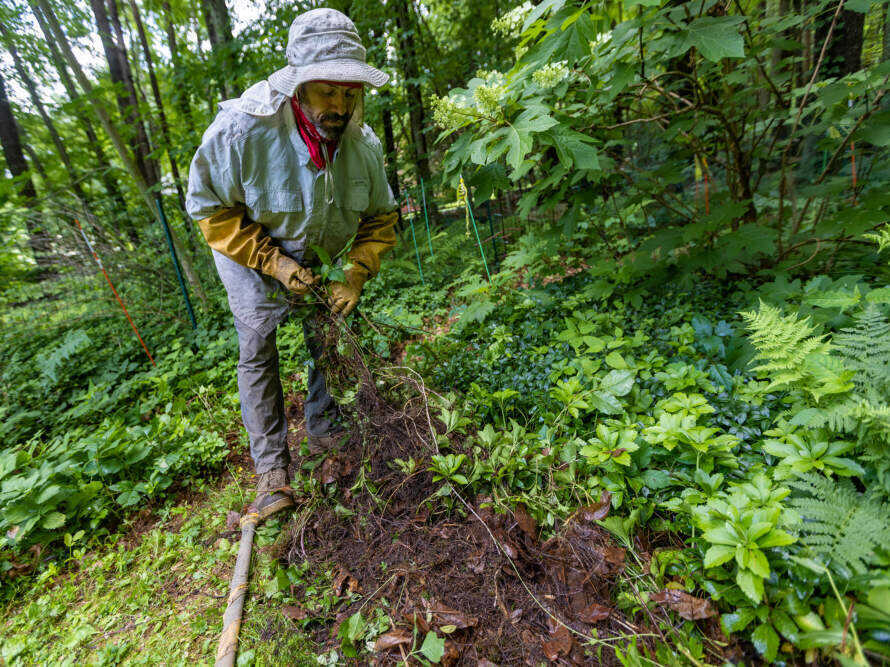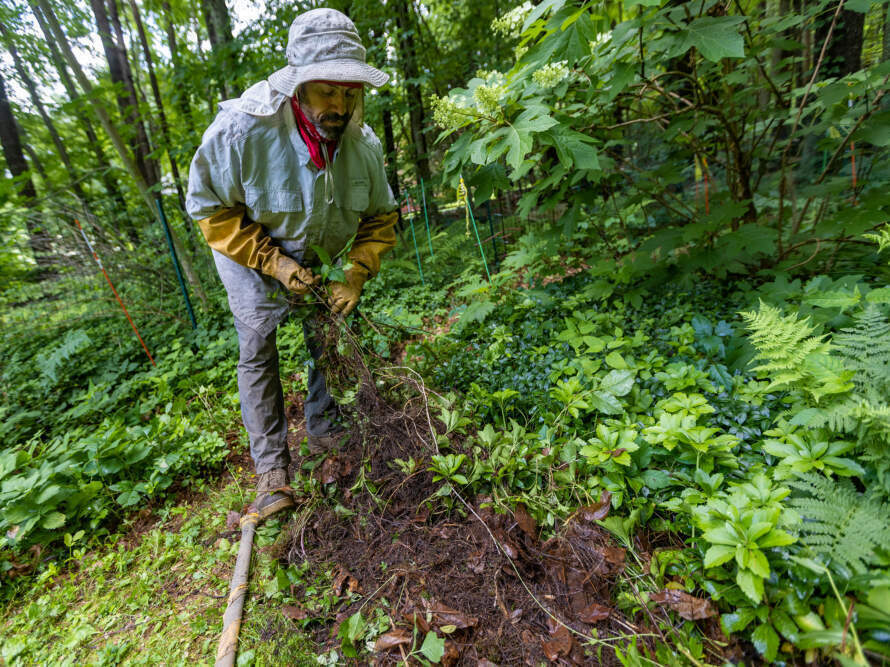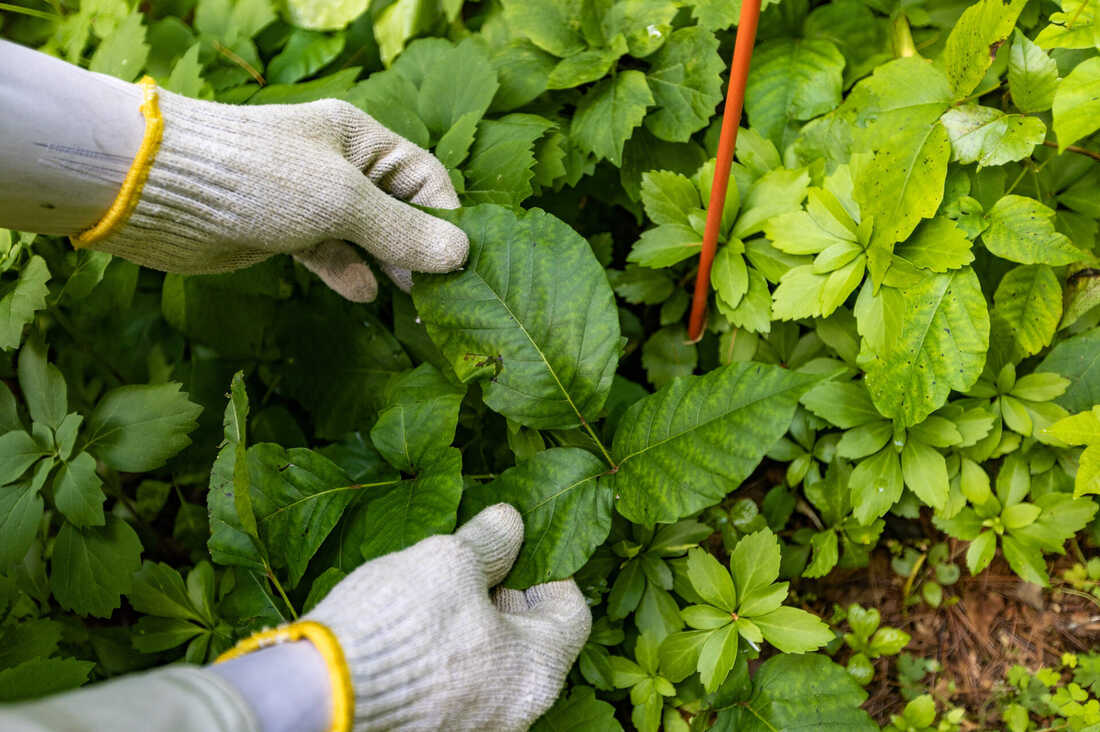

Peter Barron pulls out poison ivy vines in Harvard, Mass.
Jesse Costa/WBUR
cover caption
toggle caption
Jesse Costa/WBUR

Peter Barron pulls out poison ivy vines in Harvard, Mass.
Jesse Costa/WBUR
Over a decade in the past, when Peter Barron began casting off poison ivy for a residing, he made up our minds to record his paintings.
“Once a year I all the time take photos of the poison ivy as it is blooming,” stated Barron, who is best referred to as Pesky Pete, of Pesky Pete’s Poison Ivy Elimination.
He nonetheless recollects the pictures he took of the first actual tiny, pink, glossy poison ivy leaves coming out in Massachusetts and southern New Hampshire the place he works.
“After I first began, it was once Would possibly 10 or Would possibly 11,” he remembered. “I used to be so excited. I used to be like, ‘Wow, the season is right here.’ “
Now, if he traces up all his pictures from 14 years, the primary sighting comes nearly a month previous. In 2023, his first glimpse was once on April 18.
Barron could have unwittingly documented an impact of local weather trade.
Poison ivy is poised to be one of the vital large winners on this international, human-caused phenomenon. Scientists be expecting the scary three-leafed vine will take complete benefit of hotter temperatures and emerging ranges of carbon dioxide within the setting to develop sooner and larger — and grow to be much more poisonous.
Professionals who’ve studied this plant for many years warn there are probably to be implications for human well being. They are saying hikers, gardeners, landscapers and others might need to take additional precautions — and recuperate at figuring out this plant — to steer clear of an itchy, blistering rash. (Discover ways to establish it and check your wisdom with this quiz from WBUR.)
Barron thinks the sooner begin to the season is as a result of transferring climate patterns.
“The elements has warmed up, and the vegetation are getting heat sufficient to open and bloom previous and previous once a year in Massachusetts,” he stated. “It is very noticeable.”
Trying out the speculation
There may be science to improve Barron’s droop.
Within the past due Nineties, a crew of researchers designed an bold learn about to determine how vegetation — or even a complete wooded area ecosystem — would reply to emerging carbon dioxide ranges within the setting.

Pesky Pete Barron holds the leaves of poison ivy illustrating the way it grows in clusters of 3 leaves.
Jesse Costa/WBUR
cover caption
toggle caption
Jesse Costa/WBUR

Pesky Pete Barron holds the leaves of poison ivy illustrating the way it grows in clusters of 3 leaves.
Jesse Costa/WBUR
They constructed massive towers round six massive, round wooded area plots, to pump the gasoline into the air. The experiment was once in moderation automatic: If the wind was once blowing from the west, the towers at the west would emit the gasoline, so it might waft out over the remainder of the wooded area plot and out the opposite aspect. The speculation was once to simulate what the scientists concept prerequisites could be like in 2050.
“A cylinder of the longer term is the way in which I love to name it,” defined William Schlesinger, now an emeritus professor at Duke College, who labored at the learn about together with scientists from the government.
Over a handful of years, the researchers watched the vegetation develop sooner with extra carbon dioxide. This was once anticipated since vegetation necessarily use the gasoline as meals. The bushes grew about 18% sooner within the wooded area plots with a prime focus of carbon dioxide.
On the other hand, the vines grew even sooner, and poison ivy was once the speediest of all, rising 70% sooner than it did with out the additional carbon dioxide.
“It was once the max. It crowned the expansion of the entirety else,” Schlesinger stated.
And that is the reason no longer all: The researchers came upon that poison ivy changed into extra poisonous. The upper carbon dioxide ranges spurred the plant to provide a stronger shape of urushiol, the oily substance that reasons the nasty pores and skin rash all of us attempt to steer clear of.
“However we do not know why,” stated Jacqueline Mohan, a professor on the College of Georgia’s Odum Faculty of Ecology, who was once concerned within the learn about.
In some other experiment, Mohan discovered the vine’s leaves grew higher with extra carbon dioxide.
Extra lately, Mohan has been operating on an ongoing learn about within the Harvard Wooded area in central Massachusetts, the place researchers are artificially warming the highest layer of soil by means of about 9 levels Fahrenheit. The speculation is to simulate the impact of local weather trade and measure how vegetation reply. Poison ivy seems to like the hotter prerequisites.
“My heavens to Betsy, it is starting off,” she stated. “Poison ivy takes to the air greater than any tree species, greater than any shrub species.”
Mohan stated one reason why for this enlargement is most probably as a result of, in contrast to shrubs and bushes, vines can make investments as regards to all their power into period. They do not want to construct thick trunks or branches. Plus, she stated, the artificially hotter soil turns out to give a boost to a fungus that flourishes in heat soil and is helping poison ivy develop.
A larger itch?
With local weather trade already beginning to have an effect on international climate and atmospheric prerequisites and carbon dioxide ranges within the setting emerging, each Schlesinger and Mohan assume it is believable that poison ivy is converting.
To this point there don’t seem to be observational research at the subject. “It is a nasty plant to paintings on,” Schlesinger famous. Mohan agreed: “It is a remarkably understudied species.”
Some conservationists in Massachusetts file they are seeing extra of the vine rising round trails and yards. And medical doctors say they have noticed extra poison ivy rashes, together with the type that takes other people to the emergency room.
“Each and every one in every of us sees it each and every week,” stated Louis Kuchnir, a dermatologist with a convention of 10 medical doctors within the suburbs west of Boston. “And I imply the type of circumstances the place other people cannot sleep and are coated with blisters.”
More or less 80% of the inhabitants is allergic to poison ivy, however Kuchnir stated just a small fraction of circumstances make it to a health care provider. The severity of the response all is dependent upon how a person’s immune machine responds to the oil in poison ivy.
“Some other people can have an amazing hypersensitivity to poison ivy, and others simply do not appear to mount any hypersensitivity in any respect,” he stated.
Kuchnir suspects there could also be some other offender to believe within the uptick in poison ivy reactions in recent times — the pandemic shutting down indoor actions and nudging other people into their gardens and onto trails.
Simply as extra other people hit the paths, conservationists are noticing extra poison ivy on paths and mountaineering up the bushes. In Lincoln, Gwyn Loud has been retaining tabs on poison ivy’s increasing actual property.
“There may be much more. [It’s] everywhere,” stated Loud, who’s at the board of the Lincoln Land Conservation Agree with and has lived within the space for 55 years.
She’s spotted some other trade, too: The leaves are getting larger.
Pointing to a patch of poison ivy rising at the wooded area’s edge, she famous leaves the scale of a e book. “I don’t believe I have ever noticed leaves as large as that,” she stated.
Loud want to see some laborious knowledge, however, if her observations are proper, it isn’t just right information for the majority of people who find themselves allergic to poison ivy.


